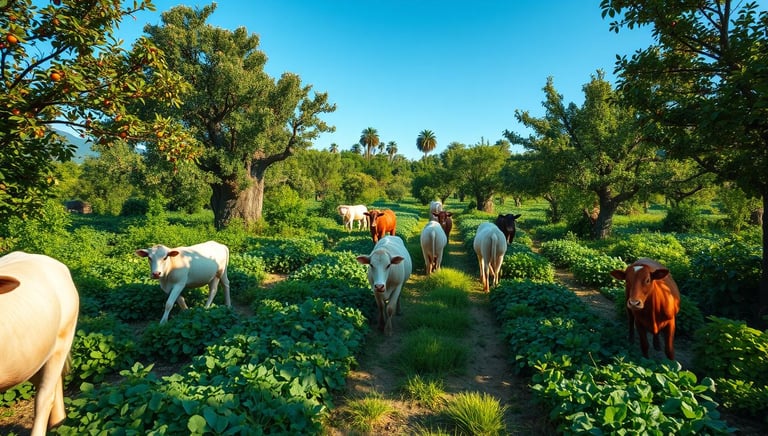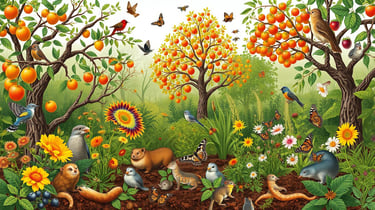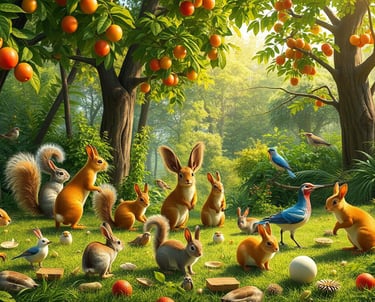Animals in Food Forest Ecosystems: Key Players
Discover how animals play crucial roles in food forest ecosystems. Learn how they have an impact on biodiversity and sustainability.
PREPPING POSTS
Kathrine-Anne Hill
10/22/202411 min read
Affiliate Disclosure:
Please note that some of the links in this article are affiliate links. This means that if you click on these links and make a purchase, I may receive a small commission at no additional cost to you. This commission helps support the maintenance and growth of this website and allows me to continue providing valuable information and recommendations. Rest assured, I only recommend products and services that I have personally used or thoroughly researched. Your support is greatly appreciated! “As an Amazon Associate I earn from qualifying purchases.” For full disclosure see our Privacy Policy and Terms and Conditions here.
Animals in Food Forest Ecosystems: Key Players
Have you ever wondered how a food forest works without animals? In a food forest, animals are crucial. They help prepare the land, control pests, cycle nutrients, and keep the ecosystem balanced12. We'll explore how animals boost a food forest's productivity and resilience. We'll also learn about the importance of balancing their inclusion.
Key Takeaways
Animals in food forests can reduce labor and fossil fuel needs through their diverse contributions.
Livestock like goats, geese, and guinea hens can effectively manage weeds, clear brush, and control pests.
Carefully integrating animals is crucial to avoid damage to young trees and ensure a thriving understory.
Diverse animal species, from pollinators to predators, play essential roles in maintaining ecosystem balance.
Food forests offer higher yields and greater biodiversity compared to traditional farms.
The Invaluable Contributions of Livestock
Adding livestock to a food forest brings many benefits. During site preparation, goats can clear brush and prepare the land for planting3.
Site Preparation and Clearing
Goats can efficiently clear unwanted vegetation by grazing in different areas. This saves time and effort. It also creates a better environment for the food forest to grow3.
Tillage and Mowing
After preparing the site, livestock continue to help manage the food forest. Pigs can till the soil for new plantings3. Sheep, goats, and cattle can also mow the understory, reducing the need for manual mowing3.
Integrating livestock into a food forest reduces labor and fossil fuel use. It promotes a healthy, diverse ecosystem3. This approach aligns with food forest design, using natural resources efficiently3.
Adding livestock to a food forest makes it more productive and sustainable34.
"Livestock play a significant role in sustainable development, contributing to 12 out of the 17 Sustainable Development Goals."3
Livestock offer many benefits, from reducing labor to improving soil and ecosystem health34.
Nature's Pest Controllers
In a thriving food forest, natural pest control is key. Livestock like chickens, ducks, and turkeys help by eating insects, slugs, and snails5.
Guinea hens, for example, eat up to 90% of their diet as bugs5. Adding these birds to your food forest cuts down on chemical use. It makes pest control more eco-friendly.
Insects, Slugs, and Snails
The food forest is full of natural pest fighters. Earthworms, for example, are key for soil health in the U.S. They help improve how well fertilizers work5. Millipedes also play a role by breaking down crop residue and mixing it into the soil5.
Ladybugs can eat 50-60 aphids a day and thousands in their lifetime. They also eat mites, scales, mealy bugs, thrips, and white flies that harm crops5. Bees, like European honeybees and bumblebees, pollinate over 150 food crops in the U.S5.
Spiders control pests in U.S. croplands, with over 600 beneficial species5. These natural helpers, along with livestock, make a balanced and sustainable food forest.
"Integrating poultry and other natural pest controllers into the food forest can significantly reduce the need for chemical pesticides, promoting a more sustainable and eco-friendly approach to pest management."
Dropped Fruit and Nut Cleanup Crew
Livestock can play a big role in cleaning up dropped fruits and nuts in a food forest6. These items can harbor diseases and pests that harm the forest. Animals like hogs, chickens, or turkeys can eat these items, stopping pests and diseases in their tracks6.
The American Guinea Hog is a small heritage breed known for its foraging ability6. A study by Michigan State found that each tree drops about 120 fruitlets in June. Pigs were used to eat these, and they were very effective6.
This not only feeds the animals but also keeps the ecosystem healthy6. The manure left behind adds nutrients to the soil, helping the forest grow stronger7.
Adding livestock to a food forest is good for both the animals and the forest7. It's a smart way to manage fruit and nut trees in a silvopasture system7.
It's crucial to manage manure carefully to follow organic standards and food safety6. The USDA Organic Standards say you can't apply raw manure 90 days before harvest6. The Food Safety Modernization Act also has rules about manure use in orchards6.
Understanding how livestock help a food forest can make it healthier and more productive7. It also gives animals a valuable source of protein7.
Challenges of Integrating Livestock
Livestock can bring many benefits to a food forest. But, adding them can also be tricky. Large animals like cattle or horses might hurt young trees by stepping on them or eating them8. Smaller animals, like chickens, hogs, and turkeys, can also mess up the understory by digging or scratching8.
To solve these problems, you might need to use tree tubes or fences, especially when trees are young8. It's important to pick the right animals and manage them well. This way, you can keep your trees and plants safe while still enjoying the benefits of livestock8.
Damage to Young Trees and Understory
Adding livestock to a food forest can be risky for young trees. Big animals like cattle and horses can easily hurt or kill new trees by stepping on them or eating them8. Smaller animals, like chickens, hogs, and turkeys, can also mess up the understory by digging or scratching, which can harm the roots and look bad8.
To protect your trees and plants, using tree tubes or fences is a good idea, especially when they're young8. By choosing the right animals and managing them well, you can make sure they help your food forest without hurting it8.
"Careful management and selection of compatible livestock breeds are crucial for successful integration of livestock into a food forest ecosystem."
The Versatile Goose: Grassy Weed Manager
Walking through my food forest, I marvel at the balance that keeps it alive. Geese are key in this balance, helping manage weeds9.
Geese eat only grasses and clovers, leaving other plants alone. This helps control weeds like star grass, which can take over9.
The African weeder goose is especially good at this. They eat weeds, making room for herbs and veggies to grow. This creates a rich and diverse food forest9.
Watching geese work, I see how they connect everything in the forest. They're not just grazers; they shape the forest itself10.
Adding geese to my forest has changed it for the better. They keep weeds down, letting plants grow. Geese are true gems in managing food forests10.
"Geese are the unsung heroes of the food forest, tirelessly working to maintain the delicate balance that sustains this vibrant ecosystem."
I'm thankful for geese in my forest. They play a big role in its success. Geese are champions in weed management, essential to a thriving food forest10.
The Role of Animals in a Food Forest Ecosystem
Animals are key in a food forest's ecosystem. They do more than just help with pests and weeds. They also help cycle nutrients and shape the forest's growth11. Adding animals to a food forest makes it a self-sustaining system.
At Keela Yoga Farm, adding chickens in 2017 was a big success11. They also have worms that grow fast, and 30 sheep keep the grass down11. Pigs help by eating different materials and making great fertilizer11.
Animals do more than just help with chores. They make the ecosystem more diverse and strong12. Forests are home to many animals and plants, each with its own role12. This diversity is key to a food forest's success.
When adding animals to a food forest, we must be careful13. The gardens at Bluenose Academy will have many plants and animals13. This mix offers many learning chances and shows how all living things are connected.
"Food forests offer rich learning opportunities in fields like ecology, biology, environmental science, nutrition, and Indigenous Knowledge."
Animals play a big role in a food forest's success13. By welcoming their help, we create systems that feed us and the environment13. As we keep learning and using these methods, we make food forests better for everyone.
Pollinators: The Unsung Heroes
In our food forest, pollinators are key but often unseen. Bees, hummingbirds, and many insects help plants bloom. They make sure we have fruits, nuts, and more to eat.
These creatures are crucial for a healthy food forest14. Almost 90% of wild flowers need them to grow. And over 75% of our food crops do too14. Without them, our food supply would suffer greatly.
But pollinators face many dangers. Diseases, parasites, lost habitats, and pesticides harm them14. Sadly, many are at risk of disappearing. We must act to save them and our food forest.
We must help these vital pollinators15. By planting the right plants, giving them water, and avoiding harmful chemicals, we can help. This way, we protect our food forest for the future.
"Pollinators are the unsung heroes of our food forests, their tireless work ensuring the bounty that graces our tables and nourishes our communities."
Pollinators are vital in our food forest14. They connect us all in a web of life. Let's celebrate their role in keeping our ecosystem healthy and full of life14.
Keystone Species: Ecosystem Anchors
In a food forest, some animals are very important. They are called "keystone" species. These animals have a big impact on the environment, even if they are not many1617.
Keystone species are essential for maintaining the balance and health of their ecosystems. In a food forest, these animals act as the anchors of the ecosystem, supporting the diverse web of life that thrives in this sustainable environment. Even though they may be few in number, the impact of these species can be significant, influencing everything from plant growth to the population dynamics of other animals. Their activities help sustain the structure and function of the ecosystem, ensuring that various habitats remain rich and diverse.
A prime example of a keystone species in a food forest could be a predator like an owl or a fox. These animals play a vital role in controlling the populations of smaller mammals and insects that could otherwise become too numerous, leading to overgrazing or damage to crops. By keeping these populations under control, they foster a healthier environment where plant diversity can flourish, which in turn contributes to improved soil health and the overall resilience of the ecosystem.
Predators and Prey
Predators like wolves or sea otters are key. They keep the food web balanced and help biodiversity1617. For example, wolves in Yellowstone helped elk numbers go down. This led to more willows and better homes for beavers and birds16.
Predators and prey create a complex web of relationships that are vital for the balance of ecosystems. These interactions are crucial for maintaining biodiversity and keeping populations in check. By controlling prey numbers, predators help prevent overgrazing and resource depletion, allowing a variety of plant species to thrive and fostering a rich habitat. This balance can be observed in different ecosystems, from forests to grasslands, where the presence of predators significantly impacts environmental health.
A notable example of this relationship is found in Yellowstone National Park, where the reintroduction of wolves caused a remarkable change in the ecosystem. With a decrease in elk populations, willow trees started to recover, which in turn created essential habitats for beavers and various bird species. This chain reaction demonstrates how predators are essential in shaping their environments. They not only regulate prey populations but also enhance the overall health and productivity of the ecosystem.
Ecosystem Engineers
Some keystone species change the environment. Beavers build dams, making new homes for others1617. African elephants help grasses grow by controlling trees. This supports animals like antelopes and zebras16.
These keystone species are vital. Losing them can harm the whole ecosystem18. We must protect them for a healthy food forest161718.
Ecosystem engineers are essential in shaping and maintaining their environments, greatly affecting the community dynamics within various ecosystems. These organisms, which can be animals or plants, create, modify, or enhance habitats that enable other species to flourish. In a food forest ecosystem, recognizing the role of animals is crucial. For example, beavers build dams that create habitats for many aquatic species, while the burrowing activities of gophers and earthworms help aerate the soil, enhancing nutrient distribution and water retention. This collaboration stabilizes the ecosystem and promotes a rich biodiversity that is vital for resilience and productivity.
"Keystone species have a greater impact on the community than expected based on their numbers or biomass."18
Conclusion
Adding animals to food forests is key for a thriving farm19. By adding livestock, pollinators, and keystone species, we create a balanced system. This balance is similar to natural ecosystems.
Animals are crucial for preparing sites, controlling pests, and cycling nutrients20. In Asia and Africa, people use 90–100 wild food species per location. Countries like India and Kenya use up to 800 species.
Adding animals to ecosystems comes with its challenges, but the advantages are significant. Diverse forests exhibit greater resilience and can recover more effectively from diseases. By harnessing the synergies found in nature, we can enhance the sustainability of our food production.
FAQ
What are the key benefits of integrating livestock into a food forest ecosystem?
Livestock add great value to a food forest. They help prepare the site and till the soil. They also control weeds and clean up dropped fruits and nuts.
How can livestock be utilized for site preparation and ongoing maintenance in a food forest?
Goats can be moved around with portable fencing to clear brush. Pigs, chickens, and geese help with mowing and tilling. This reduces the need for machines.
What is the role of livestock in natural pest control within a food forest?
Chickens, ducks, and turkeys eat insects, slugs, and snails. Guinea hens, in particular, eat up to 90% of their diet as bugs. This helps control pests in the forest.
How can livestock help with the cleanup of dropped fruits and nuts in a food forest?
Introducing hogs, chickens, or turkeys helps clean up dropped fruits and nuts. This breaks the life cycle of pests and diseases. It also provides a protein-rich food source for the animals.
What are the potential challenges of integrating livestock into a food forest, and how can they be addressed?
Larger animals like cattle can damage young trees. Chickens, hogs, and turkeys can disrupt the understory. Using tree tubes or fencing is key, especially when trees are young.
What is the unique role of geese in managing the understory of a food forest?
Geese, like the African weeder goose, eat grasses and clovers but not other plants. They help control aggressive weeds. This makes way for a more diverse understory.
How do animals contribute to the broader ecological processes in a food forest ecosystem?
Animals help with nutrient cycling and shape the understory. Their grazing and browsing influence the diversity and structure of plants. This supports a successful polyculture.
What is the importance of pollinators and keystone species in a food forest ecosystem?
Pollinators like bees and hummingbirds are crucial for plant pollination. Keystone species, such as predators, play a big role in the ecosystem's balance. They are vital for the food forest's health.
Source Links
Integrating Livestock in the Food Forest - The Permaculture Research Institute - https://www.permaculturenews.org/2013/01/24/integrating-livestock-in-the-food-forest/
Permaculture and Food Forests - Jeeva Bhavana - https://jeevabhavana.org/environment/permaculture-and-food-forests/
Livestock across the world: diverse animal species with complex roles in human societies and ecosystem services - https://www.ncbi.nlm.nih.gov/pmc/articles/PMC8527482/
10 Creepy Animals That Benefit Farms and Food - https://www.nature.org/en-us/what-we-do/our-priorities/provide-food-and-water-sustainably/food-and-water-stories/creepy-animals-benefit-farms/
agroforestry – unconventional stories from a tree crops farmer - https://elizapples.com/tag/agroforestry/
Silvopasture 101 - https://poorprolesalmanac.substack.com/p/silvopasture-101
Ecosystem management using livestock: embracing diversity and respecting ecological principles - https://www.ncbi.nlm.nih.gov/pmc/articles/PMC10105869/
Functional identity and diversity of animals predict ecosystem functioning better than species-based indices - https://www.ncbi.nlm.nih.gov/pmc/articles/PMC4309003/
an idea who's time has come ... and gone??? (permaculture forum at permies) - https://permies.com/t/33462/permaculture/Permaculture-idea-time
Integrating Animals on a Permaculture Farm - https://www.keelayogafarm.com/permaculture/integrating-animals-on-a-permaculture-farm/
Animals of the Forest - https://www.animalfunfacts.net/knowledge/362-animals-of-the-forest.html
Bluenose Academy - Food Forest - https://sites.google.com/gnspes.ca/bluenoseacademy/for-families/food-forest
World Bee Day | United Nations - https://www.un.org/en/observances/bee-day
Pollinators Are Unsung Heroes of Planet Earth - https://ucanr.edu/blogs/blogcore/postdetail.cfm?postnum=46606
Role of Keystone Species in an Ecosystem - https://education.nationalgeographic.org/resource/role-keystone-species-ecosystem/
Keystone Species, Definition, Predators, Mutualists, Ecosystem Engineering - https://www.examples.com/biology/keystone-species.html
EssayGenius AI Essay Writer - https://essaygenius.ai/essay/the-role-of-animals-in-the-ecosystem
The roles and values of wild foods in agricultural systems - https://www.ncbi.nlm.nih.gov/pmc/articles/PMC2935111/
Related Posts:
Building a Self-Sustaining Food Forest: Permaculture Principles
Creating a Survival Garden: Grow Your Own Food for Emergencies









